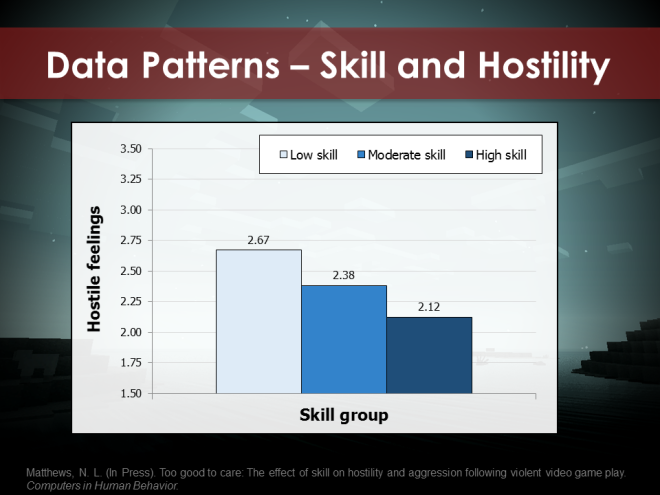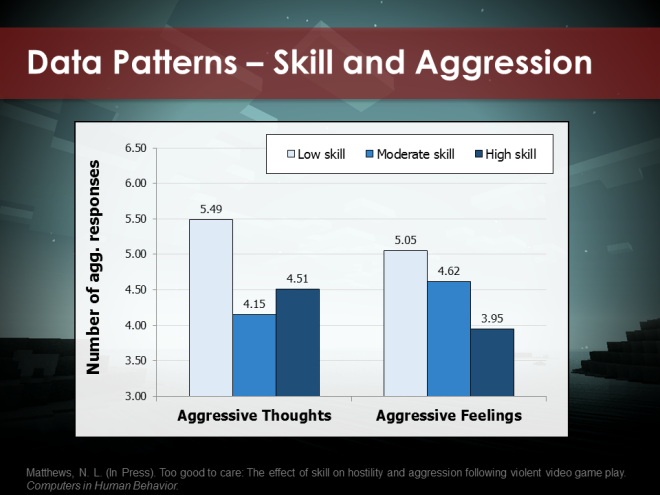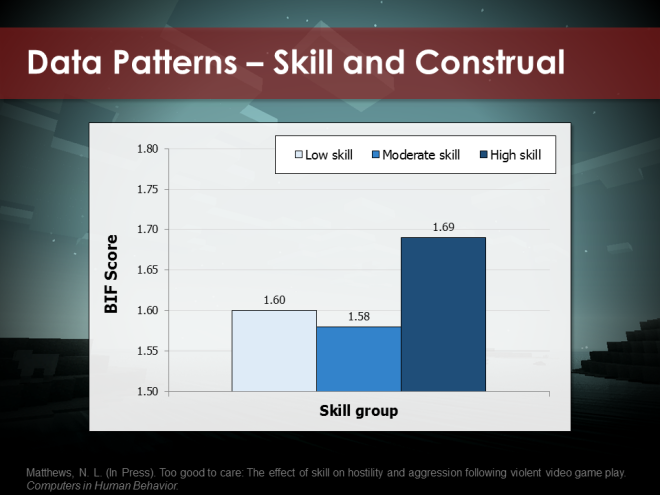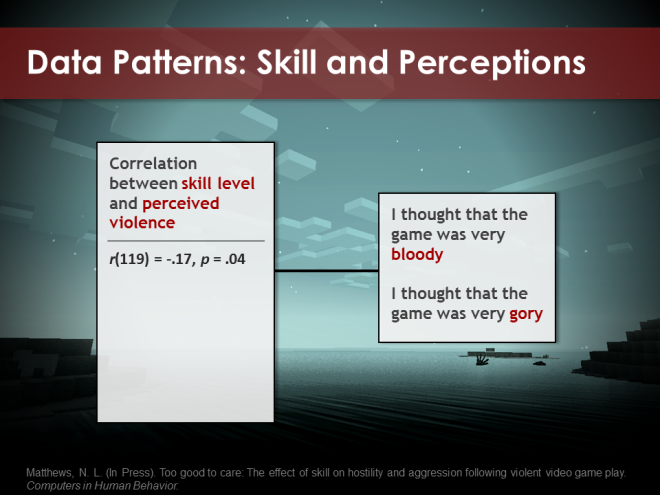The effect of skill on hostility and aggression following violent video game play
Complete Citation
Matthews, N. L. (2015). Too good to care: The effect of skill on hostility and aggression following violent video game play. Computers in Human Behavior, 48(0), 219-225. doi: 10.1016/j.chb.2015.01.059 (full text)
Basic Idea
This study investigated how skill at video games influenced hostility and aggression (i.e., aggression-related outcomes) after playing a violent video game level. The main hypotheses predicted that higher skilled players would report less aggression-related outcomes compared to lower skilled players.
Csíkszentmihályi’s Flow theory forms the basis of the predictions. Essentially, this theory suggests that people can enter into a flow state when focusing on completing a goal. Flow relies on a careful balance between one’s skill level and the challenge of the task. If skill is too high (or the challenge too low), one may become bored. In contrast, if skill is too low (or the challenge too high), one may become frustrated. This cognitive state isn’t unique to video games–it can apply to many tasks such as playing music, painting, reading, and so on.
Several perception altering characteristics are common within flow states. Specifically, flow can cause people to temporarily ignore their surroundings due to their intense focus on achieving a particular goal. The current study predicted that flow states would cause players to focus more on the goals identified by the game’s story at the cost of focusing on goal irrelevant information. One of the central hypotheses predicted that game violence is an example of goal irrelevant information. Because games (especially sandbox-style games) don’t necessarily direct players to harm other non-playable characters (e.g., enemy solders, monsters, etc.) to complete game goals, one could argue that violence isn’t central to goal achievement. In other words, a game may direct players to plunder a dungeon but the enemies are merely obstacles to the goal. Players may choose to fight every enemy head on, sneak past each mob, or use special tactics like disguises to deceive, fear spells to frighten, or calming spells to circumvent enemies. Thus, violence is but one of many means to the same end.
Nevertheless, flow states are difficult to achieve and typically short lived due to the careful balance needed between skill and challenge. Because of this relationship, I predicted that only higher skilled players would enjoy the perception-altering characteristics of flow. Specifically, I predicted that higher skilled players would pay less attention to violent video game content, as they can enter into flow states more easily compared to lower skilled players. As a result, higher skilled players would report less aggression-related outcomes.
Method
To test this possibility, this study featured a custom-built video game level using the Skyrim Creation Kit modding utility. The custom level experimentally controlled the amount, type, and context of violence. Everyone played the same dungeon that featured 9 human opponents. The level forced players to defeat each enemy one-at-a-time.
To measure flow, the study used the Flow State Scale (FSS; Jackson & Marsh, 1996) to assess 3 components of flow: concentration of the task at hand, time transformation (i.e., when time appears to move slower or faster than usual), and control of the interactive experience.
To measure hostility, the study used the State Hostility Scale (SHS; Bushman & Anderson, 2002) to assess how strongly people felt along a number of items related to hostility (e.g., angry, mean, aggravated, etc.).
To measure aggression-related thoughts, the study presented presented people with 3 interpersonal conflict stories and asked them what they thought the protagonist would think (thoughts) and feel (feelings) in each of the stories (see Bushman & Anderson, 2002). Because participants generated 4-5 thoughts and feelings for each story, I ended up with about 3,200 responses. A fellow colleague and I coded whether or not each response was aggressive or non-aggressive.
To measure skill level, the study used four questions from existing studies (Gentile et al., 2009; Matthews & Weaver, 2013). The questions asked players to rate their performance at the game they just played as well as the skill at games in general.
Finally, the study also measured perceptions of violence in two ways.¹ First, it measured construal level using the Behavior Identification Form (BIF; Vallacher & Wegner, 1989). Construal, put simply, is they way you interpret or construe something. Construals occurs on a continuum from high to low. High construals cause people to interpret objects abstractly and low construals cause people to interpret the same objects concretely. Applied to video games, I assumed that high construal levels influence players to focus less on each individual act of violence (i.e., the means to the end) and more on the narrative-driven outcomes of the violent acts (i.e., the end itself). I predicted that higher skilled players would report higher construals after playing the game.
Second, the study measured perceived violence by asking players how bloody and gory they thought the game was.
Findings





Implications
These findings provide some evidence that skill level can alter one’s perceptions of violence in ways that reduce aggression-related outcomes and even cause one to report the same content as less violent. There is some evidence that flow may be the psychological/experiential process behind these findings. However, the inconsistent findings regarding time transformation call into question this conclusion. Perhaps another mechanism is at play.
Considering the broader collection of video game violence research, the vast majority of experimental work samples participants of all skill levels–from experts to those who never play games. Thus, most work identifies the average effect on all people but not necessarily gamers–the population in question. The current findings show that skill influenced the effect of violent content such that higher skilled players experienced less aggression related outcomes after playing a violent video game. Given this, it may be that the general conclusions among video games violence research may be limited in their application to core gamers.
Similarly, there is a concern among news media that heavy consumption of violent video games may contribute to real life violence such as gun violence (see Rose, 2014). However, the current findings suggest the possibility that hardcore gamers may be less affected by violent content relative to more casual gamers. In other words, those who play often may have a resiliency to the unwanted effects of violence.
These findings also have implications for game creators as well. To reduce aggression-related outcomes, games should attempt to optimize the skill/challenge balance especially very early in the game when players are unfamiliar with game mechanics. Related, games should minimize excessively violent content in early stages until players achieve some degree of mastery over potential distractors (e.g,. control schemes, automated POV shifts, cut scenes, etc.) to maximize flow states.
Notes
1. The primary reason for measuring perceptions of violence was to provide an explanation for the current pattern of results that go beyond the frustration-aggression hypothesis. Put simply, the frustration-aggression hypothesis suggests that frustration always leads to aggression in some form. Because lower skilled players may struggle to achieve game goals, they may end up more frustrated and aggressive. Nevertheless, the frustration-aggression hypothesis does not predict altered perceptions of violent content. Thus, finding that skill and flow correlate with altered perceptions provides supporting evidence for the study’s hypotheses and helps allay the frustration-aggression confound.
Works Cited
Csikszentmihalyi, M. (1990). Flow : the psychology of optimal experience (1st ed.). New York: Harper & Row.
Bushman, B. J., & Anderson, C. A. (2002). Violent video games and hostile expectations: A test of the general aggression model. Personality and Social Psychology Bulletin, 28(12), 1697-1686. doi: 10.1177/014616702237649
Gentile, D. A., Anderson, C. A., Yukawa, S., Ihori, N., Saleem, M., Ming, L. K., . . . Sakamoto, A. (2009). The Effects of Prosocial Video Games on Prosocial Behaviors: International Evidence From Correlational, Longitudinal, and Experimental Studies. Personality and Social Psychology Bulletin, 35(6), 752-763.
Jackson, S. A., & Marsh, H. W. (1996). Development and validation of a scale to measure optimal experience: The flow state scale. Journal of Sport & Exercise Psychology, 18(1), 17-35.
Matthews, N. L., & Weaver, A. J. (2013). Skill gap: Quantifying violent content in video game play between variably skilled users. Mass Communication and Society, 16(6), 829-846. doi: 10.1080/15205436.2013.773043
Rose, M. (2014). Video games and gun violence: A year after Sandy Hook. Gamasutra.com. from http://www.gamasutra.com/view/feature/210322/video_games_and_gun_violence_a
Vallacher, R. R., & Wegner, D. M. (1989). Levels of personal agency: individual variation in action identification. Journal of Personality and Social Psychology, 57, 660-671. doi: 10.1037/0022-3514.57.4.660
